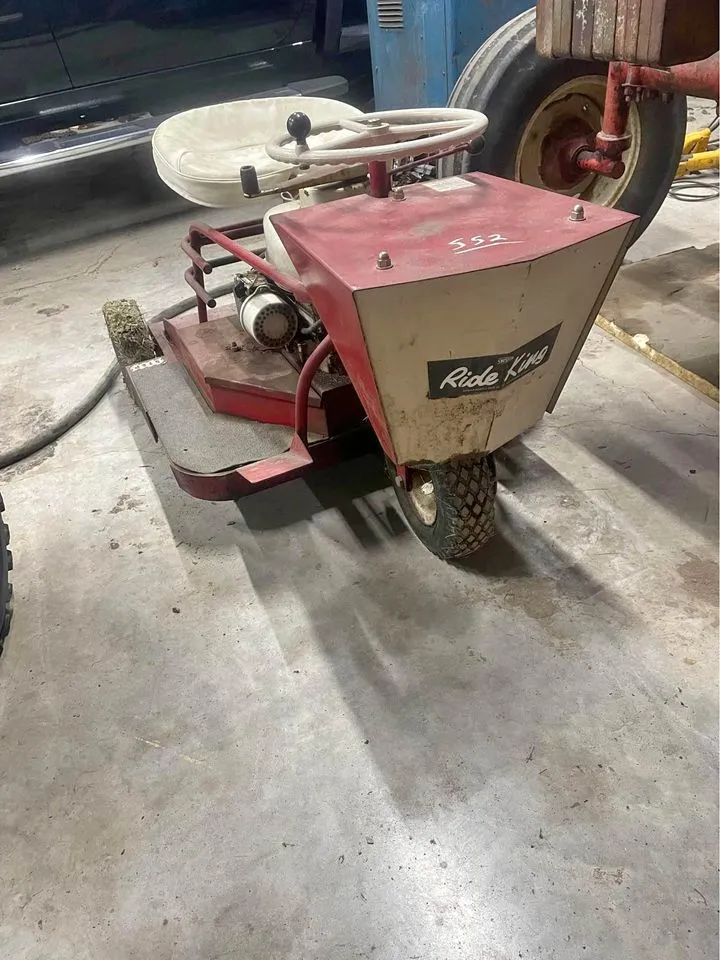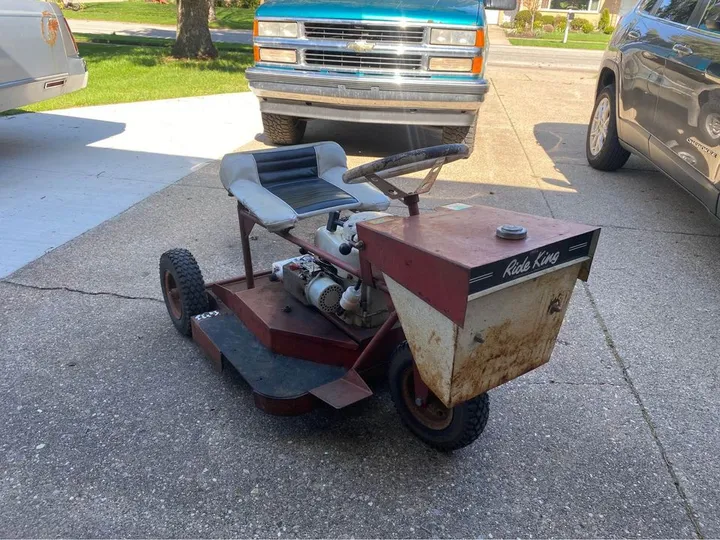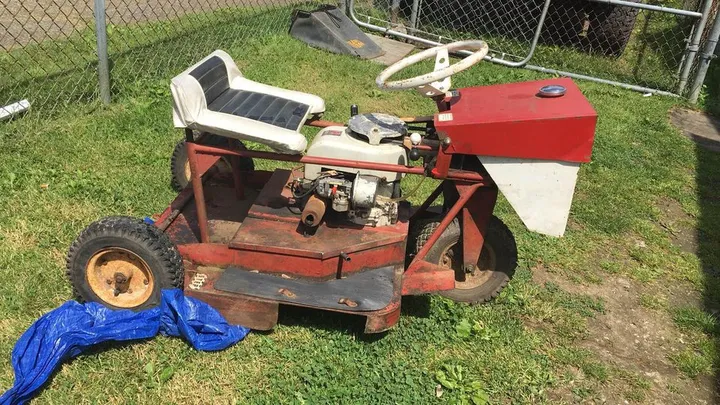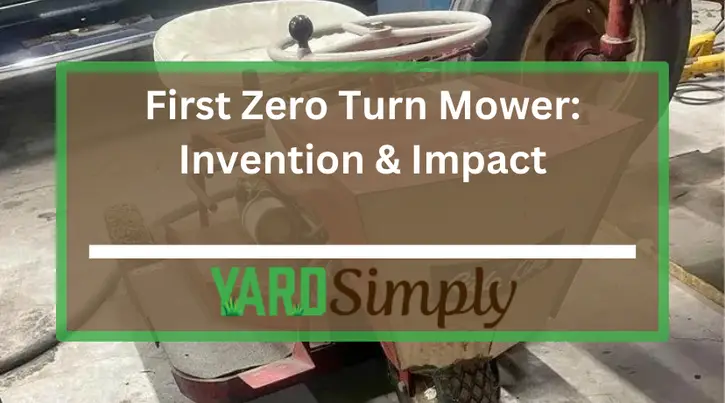When I first encountered the tale of the Ride King, the very first zero-turn mower, I was struck by the sheer ingenuity that Max B. Swisher brought into our backyards.
Back in 1949, Swisher didn’t just invent a new lawn mower; he redefined the concept of lawn maintenance, introducing a machine that could pirouette around obstacles with ease, trimming time off gardeners’ chores while improving the precision of their craft.
As I explored the mower’s origins and its impact on the industry, I realized that its significance extended far beyond the blades and the grass they cut.
The zero turn mower’s influence on landscaping efficiency and the evolution of lawn equipment beckons a closer look at its history and legacy.
Join me as I uncover the story of this unsung hero of garden innovation and consider how it continues to shape our approach to lawn care today.
Quick Summary
- The Ride King, introduced in 1949 by Max B. Swisher, was the first zero-turn mower, revolutionizing lawn care with its unique maneuverability and efficiency.
- This pioneering mower featured a unique three-wheel design, enabling tight turns and precise control, which was not possible with traditional lawn mowers of the time.
- Since the introduction of the Ride King, zero-turn mowers have evolved to reduce lawn maintenance time by up to 50%.
- Personally, I find the innovation and lasting impact of the Ride King on modern lawn care technology both remarkable and inspiring.
The Ride King
The Ride King revolutionized lawn care in 1949 as the first zero turn mower to hit the commercial market, pioneering a new era in efficient landscaping.
I can’t help but marvel at the ingenuity of Mx B. Swisher, who, from his small shop in Warrensburg, Missouri, crafted something so transformative for garden enthusiasts and professionals alike.
Unlike the zero turn mowers of today, the Ride King sported an unconventional design with one driving wheel at the front and two driven wheels at the back.
This configuration meant that to harness its zero turn capability, I’d have to throw it in reverse.
It might sound odd now, but back then, it was groundbreaking—allowing for tighter turns and more precise maneuvers around intricate garden beds and tree trunks that would’ve challenged any traditional mower.
The Ride King didn’t just cut grass; it cut the time I’d spend on lawn care dramatically. Its impact was immediate and profound.
As I sat on that original three-wheeled marvel, I felt a sense of control and efficiency I never knew possible in lawn maintenance. It set the standard for what a good mower should do: save time without sacrificing the quality of work.
And that’s a legacy that has stood the test of time.
The Invention of the First Zero Turn Mower
I’ve always been fascinated by how necessity spurs innovation, especially in the case of the first zero turn mower.
Max B. Swisher wasn’t just tinkering in his Missouri workshop; he was about to revolutionize lawn maintenance with his creation, the Ride King.
I’m eager to explore his background, the eureka moment that led to its development, and the distinctive features that set this pioneering model apart.
The Inventor’s Background
While revolutionizing lawn care in 1949, Max B. Swisher, a creative entrepreneur from Warrensburg, Missouri, invented the first commercially available zero-turn mower known as the Ride King.
I wasn’t a typical inventor with a garage full of gadgets; rather, my knack for innovation stemmed from sheer necessity and a drive to improve efficiency.
I noticed the time-consuming effort it took to trim and maintain lawns with conventional mowers, and it sparked my desire to create a solution that would ease the burden.
Dedicated to this vision, I tinkered relentlessly, drawing upon my background in mechanics and a deep understanding of the challenges homeowners and landscapers face.
The resultant Ride King was a testament to my belief that necessity is indeed the mother of invention.
Inspiration and Development Process
Building on my relentless tinkering and the challenges homeowners faced with existing mowers, my journey to develop the first zero turn mower began in a modest Missouri workshop.
I noticed how traditional mowers were cumbersome and inefficient for intricate lawns with obstacles. Convinced there had to be a better way, I set my mind on creating a mower that could pivot on its own axis.
I experimented with different configurations, eventually landing on a unique three-wheel design. The Ride King, as it was later called, had a single driving wheel in the front, allowing it to turn in a complete circle without moving forward or backward.
This was a game-changer, making mowing around trees and flower beds a breeze and forever transforming lawn care.
Key Features of the First Model

The Ride King revolutionized lawn maintenance with its unprecedented three-wheel design, allowing for unparalleled maneuverability and efficiency.
As I delve into this innovative machine’s key features, I’m struck by the simplicity of its concept yet the radical improvement it brought to lawn care.
Its unique single front wheel enabled the Ride King to pivot around its own axis, essentially turning on a dime, or rather, zeroing in without the need for a wide turning radius.
This design meant I could navigate around obstacles with ease, reducing the time spent trimming edges separately. Moreover, the rear wheel drive provided the traction needed for steady control, even on slopes.
It’s clear that the Ride King’s features set the standard for the future of lawn mowers.
Impact of the First Zero Turn Mower on Lawn Care
When the first zero turn mower, the Ride King, hit the market, it revolutionized lawn care with its agility.
I’ve noticed that its introduction led to a significant shift in how both commercial and residential users maintain their green spaces.
The advantages over traditional mowers sparked changes in maintenance practices that continue to influence the industry today.
Advantages Over Traditional Mowers
Max B. Swisher’s invention of the Ride King revolutionized lawn care by introducing a level of maneuverability traditional mowers couldn’t match, allowing for faster, more efficient cutting.
I’ve found that the zero turn capability drastically reduces the time I spend trimming around obstacles and changing directions. Traditional mowers require wider turns and often leave uncut grass that necessitates additional passes.
With my zero turn mower, I can pivot around trees and flower beds with ease, which means I’m not doubling back to catch missed spots.
This precision not only saves time but also fuel, making my lawn care routine more economical and environmentally friendly.
Plus, the reduced physical effort to operate these mowers has turned a once arduous task into a more enjoyable experience.
Changes in Lawn Maintenance Practices

Introducing the Ride King in 1949 fundamentally transformed the efficiency and methods of lawn maintenance, allowing homeowners and professionals alike to maintain their grounds with unparalleled precision.
Suddenly, I could zip around trees and flower beds with ease, making a task that once took hours much quicker. The zero turn capability meant I didn’t have to waste time maneuvering in tight spaces or making several passes to cut the grass evenly.
The impact on my lawn care routine was profound. The speed and agility of the mower cut my mowing time in half, while the closeness of the cut reduced the frequency needed.
It wasn’t just about saving time; it was about elevating the entire aesthetic of my yard with crisp edges and consistent grass height.
The first zero turn mower didn’t just change how I mowed; it changed the standard for what a well-maintained lawn should look like.
Adoption by Commercial and Residential Users
The Ride King’s breakthrough design quickly caught the attention of both commercial landscapers and discerning homeowners, revolutionizing the way they approached lawn care.
I’ve seen how its agility and efficiency transformed the tedious chore of mowing into a faster, more enjoyable task.
Commercial users, in particular, found that zero turn mowers helped them complete jobs more swiftly, allowing them to take on more clients and increase profitability.
As for homeowners, they weren’t left behind. Those with larger properties embraced the mower’s precision and time-saving capabilities.
It’s clear that the Ride King didn’t just change how lawns were mowed; it altered the landscape of the lawn care industry itself, setting new standards in maintenance that are still influential today.
Technological Advancements in Zero Turn Mowers
Since the inception of the Ride King, zero turn mowers have seen significant improvements.
I’ll explore how modern technologies have been integrated into these machines, enhancing performance and user experience.
We’ll also see how today’s models stack up against their predecessors in terms of efficiency and features.
Improvements Since the First Model
Zero turn mowers have undergone significant technological evolution since the Ride King’s inception, enhancing maneuverability, comfort, and efficiency for users.
I’ve seen models that boast improved hydraulic systems for smoother operation and better control. They now come with ergonomic seats and controls that reduce fatigue during long mowing sessions.
I’m particularly impressed by the fuel efficiency advancements and the introduction of electric models, which are quieter and more eco-friendly.
Manufacturers haven’t stopped at just performance; they’ve also integrated smart technology. I can now find mowers with onboard diagnostics and GPS tracking, which help in maintaining the machine and optimizing mowing patterns.
It’s clear that the zero turn mower has come a long way, making lawn care quicker and more enjoyable than ever before.
Integration of Modern Technologies
Embracing modern technology, today’s zero turn mowers feature advanced onboard systems that enhance the mowing experience far beyond their predecessors.
I’m amazed at how they’ve evolved with features like GPS navigation for precision cutting paths and programmable memory settings. I’ve even seen models with LED headlights for mowing in low light conditions.
These mowers aren’t just about cutting grass anymore; they’re about doing it efficiently and comfortably. I can sit in a high-backed, adjustable seat with suspension that minimizes the bumps and jolts.
There’s also the convenience of electronic fuel injection engines that start easily and adjust to varying conditions, which I find incredibly handy.
It’s like they’ve thought of everything, turning what was once a chore into a high-tech ride.
Comparison with Current Models
Comparing the Ride King to modern zero turn mowers highlights a technological evolution that has transformed these machines into highly efficient and user-friendly lawn care tools.
Nowadays, I’m seeing models sporting multiple features that make mowing less of a chore and more of a breeze. They’ve got powerful engines, wider cutting decks, and ergonomic designs that ensure comfort during long hours of work.
Most impressively, today’s mowers boast advanced control systems. I can maneuver with precision thanks to smooth steering levers, and some even come with joystick controls.
They’re also equipped with safety features like automatic shut-off sensors, which the Ride King didn’t have.
It’s clear that modern zero turn mowers are leagues ahead, offering speed, comfort, and safety that the first models simply couldn’t match.
Zero Turn Radius Technology Evolution

The evolution of zero turn radius technology, from the Ride King’s basic maneuverability to the sophisticated systems in the Cub Cadet Ultima ZT2, represents significant advancements in lawn mower design.
The newer models feature more precise and agile steering mechanisms, offering enhanced control and speed, which drastically reduce the time and effort required for lawn maintenance.
This technological leap has transformed zero turn mowers into highly efficient tools for both residential and commercial landscaping needs.
Innovations in Lawn Mower Comfort
The journey from the Ride King to the modern Cub Cadet Ultima ZT2 showcases significant progress in operator comfort.
Early zero turn mowers like the Ride King had basic functionality with little focus on user comfort, whereas current models, including the ZT2, emphasize ergonomic design.
This includes features such as adjustable, cushioned seats, vibration dampening systems, and ergonomic control bars, which collectively reduce operator fatigue and enhance the mowing experience.
Maintenance and Durability Advances
Modern zero turn mowers, like the Cub Cadet Ultima ZT2, boast significant improvements in maintenance requirements and durability compared to their predecessors like the Ride King.
Innovations such as maintenance-free spindles, high-quality corrosion-resistant materials, and robust frame designs not only extend the lifespan of these mowers but also simplify upkeep.
These advancements ensure that modern mowers remain reliable and efficient over prolonged periods of use.
Deck Technology and Cutting Efficiency
Cutting deck technology has seen remarkable advancements since the era of the Ride King. Modern mowers, exemplified by the Cub Cadet Ultima ZT2, feature cutting decks designed for optimal efficiency and performance, like the AeroForce deck.
These decks offer a superior cut with minimal clumps, fine clippings, and more evenness, enhancing the overall quality of lawn care.
Deck’s adjustable cutting heights and improved blade designs also contribute to the versatility and efficiency of these mowers.
Environmental Considerations and Fuel Efficiency
The shift from the early zero turn mowers like the Ride King to current models like the Cub Cadet Ultima ZT2 reflects a growing emphasis on environmental considerations and fuel efficiency.
Modern mowers are designed with more efficient engines and larger fuel tanks, reducing the frequency of refueling and contributing to better fuel economy.
This evolution signifies the lawn care industry’s move towards more sustainable and cost-effective lawn maintenance solutions.
Our Verdict
I must say, the history of the Ride King and its monumental impact on lawn care has been an eye-opener for me.
Having had the chance to operate a zero turn mower myself, I’m thoroughly impressed by the efficiency and precision these machines bring to lawn maintenance.
It’s like they’ve transformed a routine chore into an almost artistic endeavor, where every turn is precise and every minute saved is a nod to the innovation of Max B. Swisher.
Reflecting on the journey from the Ride King to the advanced mowers of today, I’m not just impressed; I’m inspired by the relentless pursuit of better, smarter lawn care solutions.
Truly, the legacy of the Ride King is a testament to human ingenuity and the endless possibilities it presents.
Frequently Asked Questions
How did the initial design of the Ride King influence lawn mower safety standards over time?
I’m not sure how the Ride King’s initial design specifically influenced safety standards, but its unique setup certainly pushed for better control mechanisms and user safety features in later mower designs.
What were the economic implications for Swisher’s business after releasing the first zero turn mower?
After releasing his innovative mower, his business saw a spike in sales. It revolutionized lawn maintenance, leading to significant growth and establishing my brand in the competitive landscaping equipment market.
How did the introduction of the Ride King affect the market for traditional lawn mowers at the time?
I believe the Ride King’s introduction shook up the traditional lawn mower market by offering quicker maneuverability and efficiency, compelling rivals to innovate or risk falling behind in the landscaping equipment industry.
Were there any notable legal or patent disputes involving the Ride King after its invention?
I’m not aware of any significant legal or patent disputes involving the Ride King following its invention. It seems to have entered the market without facing such challenges.
How did the zero turn technology propagate internationally following the invention of the Ride King?
I’m not sure how the zero turn technology spread globally after its initial invention. It likely involved trade shows, international patents, and partnerships with overseas manufacturers to reach a wider market.


